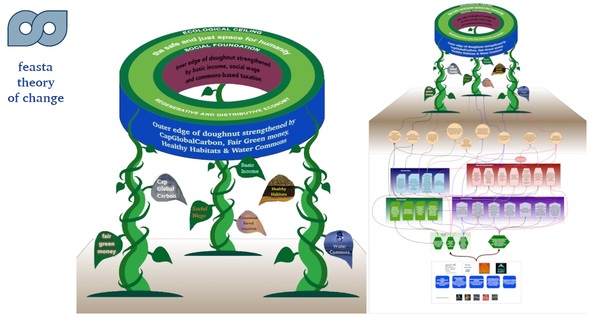The word ‘Feasta’ means ‘in the future’ in Irish. We’re an ecological economics think tank and forum for debating and communicating about the characteristics of a truly sustainable society. We've been going since 1998 and one of Feasta’s co-founders was the late economist Richard Douthwaite, who wrote a book called ‘The Growth Illusion’ in 1992, that was an early critique of GDP growth as a measure of progress.
Feasta is based in Ireland but has international membership (and several of our members in and around Ireland are also involved with the Irish Doughnut Economics Network). We’ve been taking a systems-based approach to economics ever since Feasta’s founding. Rather than assuming that problems are being caused by people deliberately behaving badly, we tend to assume that they're caused by bad systems and we work (alongside many partners) to come up with better ones.
Our focus is often quite global. We think it's very important to think globally as well as locally, since the great work that's often done locally risks being swept away or distorted by broader economic dynamics, unless those dynamics are changed too.
Every year we update our Theory of Change, which is a general plan for an organisation in which long-term goals are defined and then mapped backward to identify necessary preconditions. Thankfully we don't have to do all the tasks mentioned in it by ourselves!
Beginning with last year’s Theory of Change, we thought it would be a good idea - and fun - to incorporate the Doughnut. We put the Doughnut at the top of our Theory for Change diagram, because it’s the ultimate outcome we’re aiming towards. We tilted it a bit so that you can see more of the inner and outer edges.
The Doughnut is being held up by three supports, which represent initiatives that Feasta members think are important. The idea is that they all, or something like them, are interdependent and necessary - if you take one away then the whole thing will fall over.
Last year the supports were red sticks, but after a while they began to look a bit too much like plastic straws for our comfort :). So this year we decided to replace them with climbing plants. These are not only more beautiful, but also seem much more appropriate, as we think of the system that supports the Doughnut as alive. In our website version, the initiatives on the plant leaves are dynamic links.
It’s all resting on a ‘ground’ which is being ‘nourished’ by the short, medium and long term actions that we think could support this process. There’s an outline view which just has headings for these, for people who like to keep things simple, and a detailed view with a tangled spaghetti of colour-coded arrows, for those who like a tad more complexity.
If you’re curious to know more, you can check the whole thing out on our website at https://www.feasta.org/theory-of-change/ .
We had a lot of fun doing this - we brainstormed what to do in online meetings and then one of us worked up the draft. It really pushed the limits of free graphic design software! We consider it a living document, as the process of working on it is as important as the end product.
If anyone else would like to use some or all of our model, feel free - we’d just appreciate if you could let us know at website@feasta.org . Questions and comments are very welcome, too.

